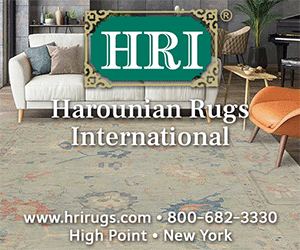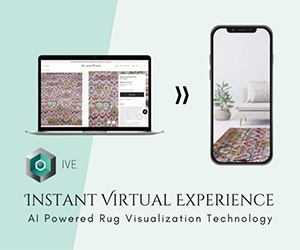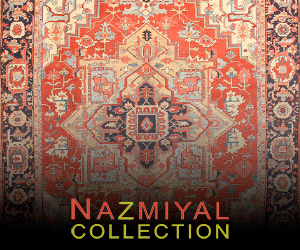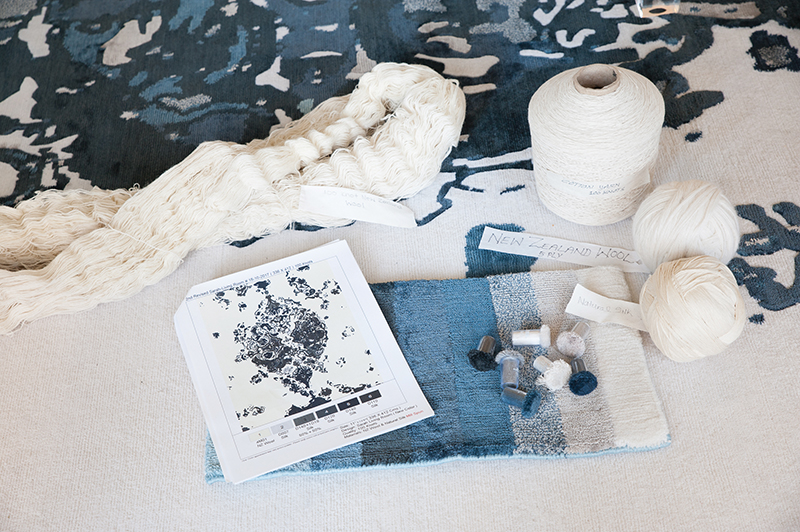If you have to ask yourself, “Have I met Ali Ghassemi?” the answer is—with a high degree of certainty—most likely “No.” I vividly remember the first time I met him. After repeated invitations to come to his Toronto, Ontario showroom, the subsequent visit turned into an hours-long presentation on his part. All because of his unforgettably passionate belief in not only what he is doing, but also its importance to the rug industry. This is his approach to truly bespoke rugs. He thinks it should be yours as well. Presented in two parts, the concluding portion appears in Rug Insider Fall 2019.
If we agree that we currently live in a consumption driven society—and we do—then we should also agree that designers, makers, importers, wholesalers, retailers, and the like should attempt to provide the goods and services that best meet the needs and wants of consumers. For the rug and carpet industry, in particular the hand-knotted portion thereof, this has been an uneasy course to chart given the history of the craft and the romance often ascribed thereto. In fact, until relatively recently, perhaps the past two decades, consumers were more or less given the option—if it can be called that—of either purchasing the rug at hand in a retail shop or not. Perhaps it was available in another size, or another pre-existing colorway, but that was the sum of the so-called options.
Then digital technology transformed everything, becoming a strange and uneasy bedfellow with the ancient craft of carpetry. By way of innovations in communication, design software, and logistics the hand-knotted rug industry was suddenly able to bring fully-customized rug making to a wide swath of consumer demographics. No longer confined to the extreme niche at the very top of the market, custom rugs became at first en vogue, then almost de rigueur—especially for those working with the Interior Design and Architectural trades. Interjecting once again a bit of marketing romance, these rugs and carpets have been called custom, bespoke, and made-to-order to name but a few examples. Then suddenly, the options for buying a rug became virtually endless! If a customer did not see what they desired in the showroom, a savvy salesperson would simply direct them toward a custom option and, after the requisite production and shipping time deliver the finished rug, thus pleasing the customer. Or as Ali Ghassemi believes, pleasing them for the most part.
“If you want my two cents—and I guess you do since we are talking—no-one in 2010 was using the term bespoke to describe rugs. Now you see it everywhere, but again, no-one is making bespoke rugs the way I think they should be made,” begins Ghassemi as we spoke via telephone. “What happens when you go into a rug showroom and they tell you that you can have a custom rug? What options are they offering? Size, coloration, maybe shape, perhaps minor design changes, probably some minor material options, but all selected from an existing library of designs. That’s customized but it’s not bespoke.”
Ghassemi makes this assertion based on parallels drawn with the fashion industry, most notably the bespoke men’s suit. If we equate an off-the-rack suit that has been tailored-to-fit with the customized rug previously described, then a bespoke suit matching the precise specifications of the client is more akin to… well a bespoke carpet that likewise satisfies the precise needs and wants of the client—that is to say, their parameters.
“My approach is to come to the canvas of the carpet from scratch. No preexisting colors, design, materials, et cetera. Where do we start?” Ghassemi asks rhetorically. “With the parameters that exist. And, it is the role of Weaver and Loom [Ghassemi’s Toronto showroom which has for the past several years served as his proof of concept.] to find out what these are.”
At the core of Ghassemi’s approach is ultimate customer satisfaction—by genuinely matching not only the wants of the client but their needs as well, with an ideally configured bespoke carpet. “You know how it is Michael,” begins Ghassemi before I interrupt and remind him not everyone does. “A client goes into a typical rug showroom and they fall in love with something that is not suited to their parameters. The rug may meet the parameters of the salesperson or showroom owner, but does it check all the boxes for the client?”
“Yes, on rare occasion,” I coyly reply before conceding Ghassemi’s point that this approach can lead to disappointment all around. Perhaps the client truly does loves the 100% silk rug. That is, until the price is revealed. “Now the client is unsatisfied as is the showroom,” concludes Ghassemi. “We cut through all that bull, and it starts with our Bespoke Service Questionnaire.”
“The client is presented with all the options available to them that meet their parameters. They can touch and feel the hand of the finished carpet even before they know what it will look like.“
In short, Ghassemi begins by asking a series of direct questions irrespective of what the eventual design—the drawing or image—of the carpet will be. It simply does not matter at this stage. All other criteria are considered however but it starts by asking the ideal desired size, followed immediately by the budget for the carpet under consideration.
“We all have a budget. And most of the time, when you ask a client what their budget is they 1) Already know what they want to spend, and 2) Have likely formulated this based on having shopped for rugs elsewhere,” states Ghassemi before pressing me to role-play in a scenario in which I am a client. “What’s your ideal size?”
For illustrative purposes we imagine I am rug shopping for my fictitious private television room off the master bedroom. The rug needs to be 8'5" x 9'0" (2.57m x 2.74m) and my budget is $5500 USD. “The best part is that the client sets the price. No-one is pressuring the client to spend more,” adds Ghassemi who then does the mathematics. “Seventy-five point seven five square feet… divided into your budget… $72.60 per square foot. That is your budget.” His bespoke process also queries as to who will be using the space, whether there are pets, what the function of the rug will be, and so on and so forth so that in the next step, the joy of Ghassemi’s approach can reveal itself through the incomparable sensation of touch.
The prospective client is then shown a series of plain, off-white hand-knotted samples that fall within the per-square-foot budget and are appropriate for their parameters. The samples are plain, so that color and design do not unduly influence the process. Given my scenario, a breadth of material options are not only available but also suitable to the situation. “Function is very important,” adds Ghassemi. For example, had my rug been intended for the primary entry, Ghassemi would not show a sample with viscose. Since the room is very low traffic, the fiber remains suitable—subject of course to the tastes of the client. “The client is presented with all the options available to them that meet their parameters. They can touch and feel the hand of the finished carpet even before they know what it will look like.”
The selection of the quality—the sum of all the constituent technical details: country of origin, material, density, et alia as opposed to measure of craftsmanship—is made without regard to the underlying specifics. Only the client’s parameters matter and as such a contender sample may be from India just as it may be from Nepal or elsewhere. “We’re the maker, and that is a key component of this bespoke process. We’re bringing all the options directly to the consumer without unnecessary filters and letting the customer decide based on the factual information presented,” says Ghassemi.
Once the client selects a quality the design process begins. “At this point we ask a client to provide us mood boards, fabric samples, and other information that we then use to create a design suited to the predetermined quality, the characteristics, of the finished carpet,” explains Ghassemi. “The budget is already set and we create a design—based on our expertise—that is perfectly suited to the quality the client has selected, their parameters.”
How the design develops, and the rest of Ghassemi’s process and thoughts—including his views on the imprecision of hand-[insert vague word here]—appeared in the Fall 2019 issue of Rug Insider Magazine. The story continues… with Old Craft, New Work - Part II.
Images courtesy of Ali Ghassemi.





